Abstract
1. In precollicular decerebrate rabbits we investigated the effect of sympathetic stimulation, at frequencies within the physiological range, on the tonic vibration reflex (TVR) elicited in jaw closing muscles by small amplitude vibrations applied to the mandible (15-50 microns, 150-180 Hz). The EMG activity was recorded bilaterally from masseter muscle and the force developed by the reflex was measured through an isometric transducer connected with the mandibular symphysis. 2. Unilateral stimulation of the peripheral stump of the cervical sympathetic by the TVR, and a marked decrease or disappearance of the ipsilateral EMG activity. No significant changes were detected in the EMG contralateral to the stimulated nerve. Bilateral CSN stimulation reduced by 60-90% the force reflexly produced by the jaw closing muscles and strongly decreased or suppressed EMG activity on both sides. This effect was often preceded by a transient TVR enhancement, very variable in amplitude and duration, which was concomitant with the modest increase in pulmonary ventilation induced by the sympathetic stimulation. 3. During bilateral CSN stimulation, an increase in the vibration amplitude by a factor of 1.5-2.5 was sufficient to restore the TVR reduced by sympathetic stimulation. 4. The depressant action exerted by sympathetic activation on the TVR is mediated by alpha-adrenergic receptors, since it was almost completely abolished by the I.V. administration of either phentolamine or prazosin, this last drug being a selective antagonist of alpha 1-adrenoceptors. The sympathetically induced decrease in the TVR was not mimicked by manoeuvres producing a large and sudden reduction or abolition of the blood flow to jaw muscles, such as unilateral or bilateral occlusion of the common carotid artery. 5. The effect of sympathetic stimulation was not significantly modified after denervation of the inferior dental arch and/or anaesthesia of the temporomandibular joint, i.e. after having reduced the afferent input from those receptors, potentially affected by CSN stimulation, which can elicit either a jaw opening reflex or a decrease in the activity of the jaw elevator muscle motoneurons. 6. These data suggest that, when the sympathetic nervous system is activated under physiological conditions, there is a marked depression of the stretch reflex which is independent of vasomotor changes and is probably due to a decrease in sensitivity of muscle spindle afferents.
Full text
PDF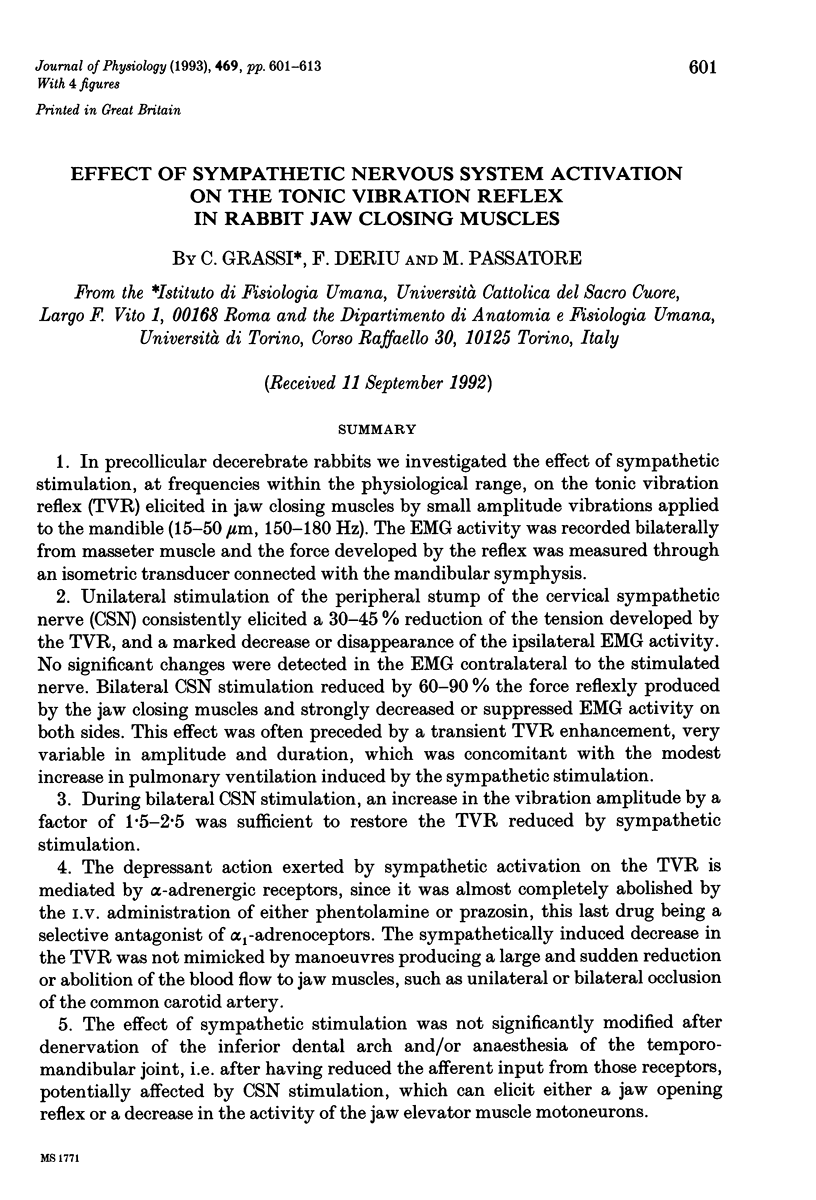
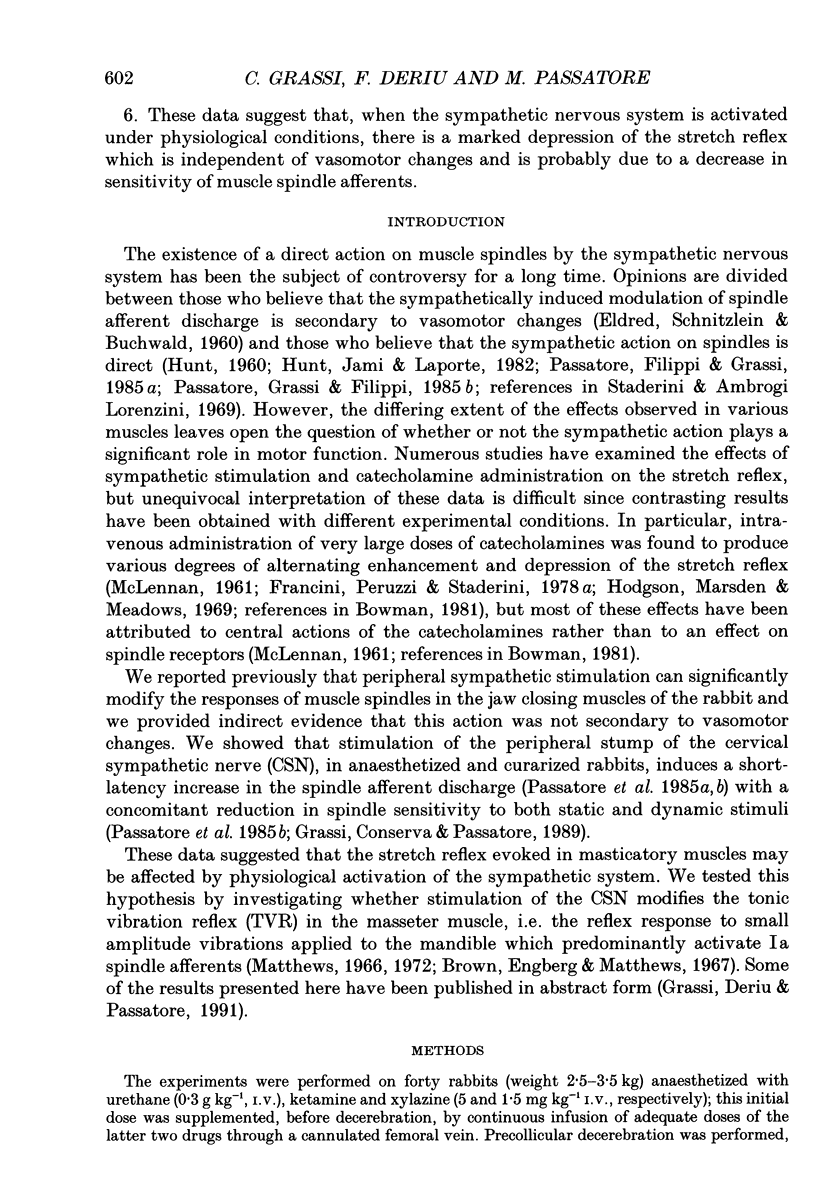
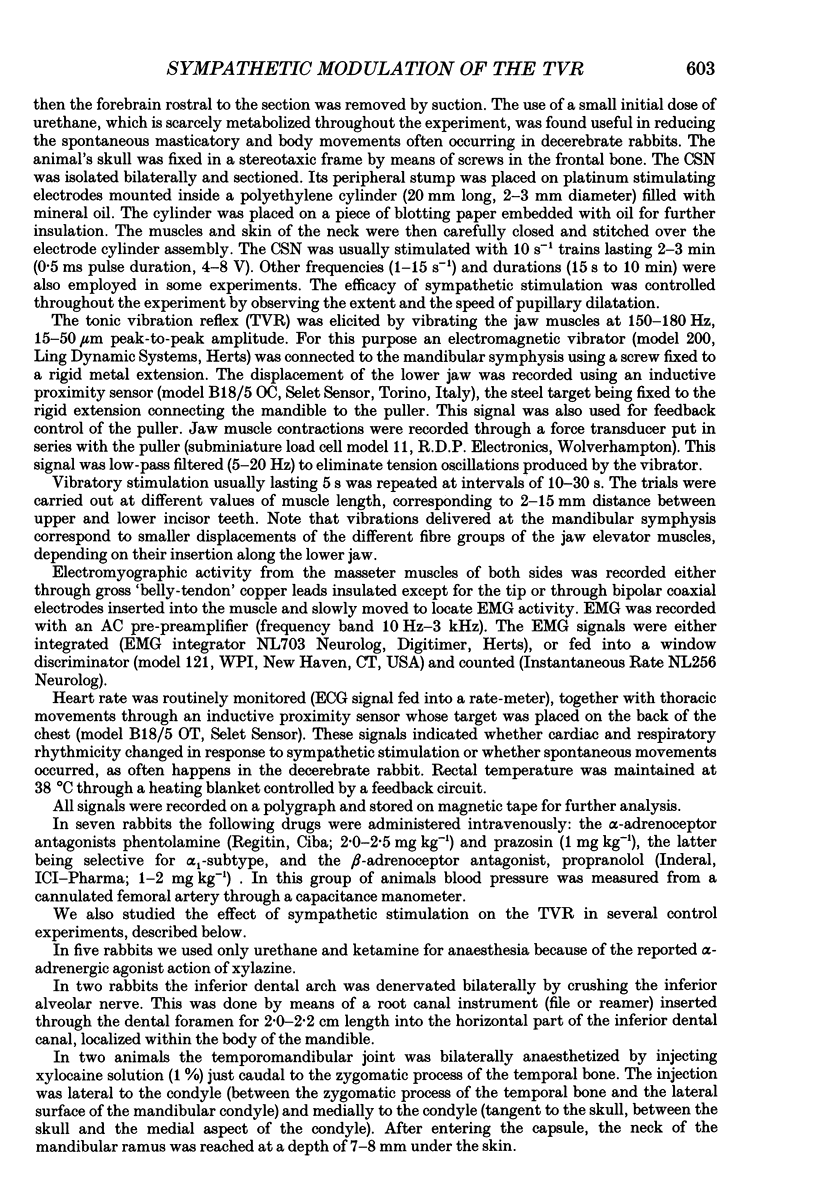
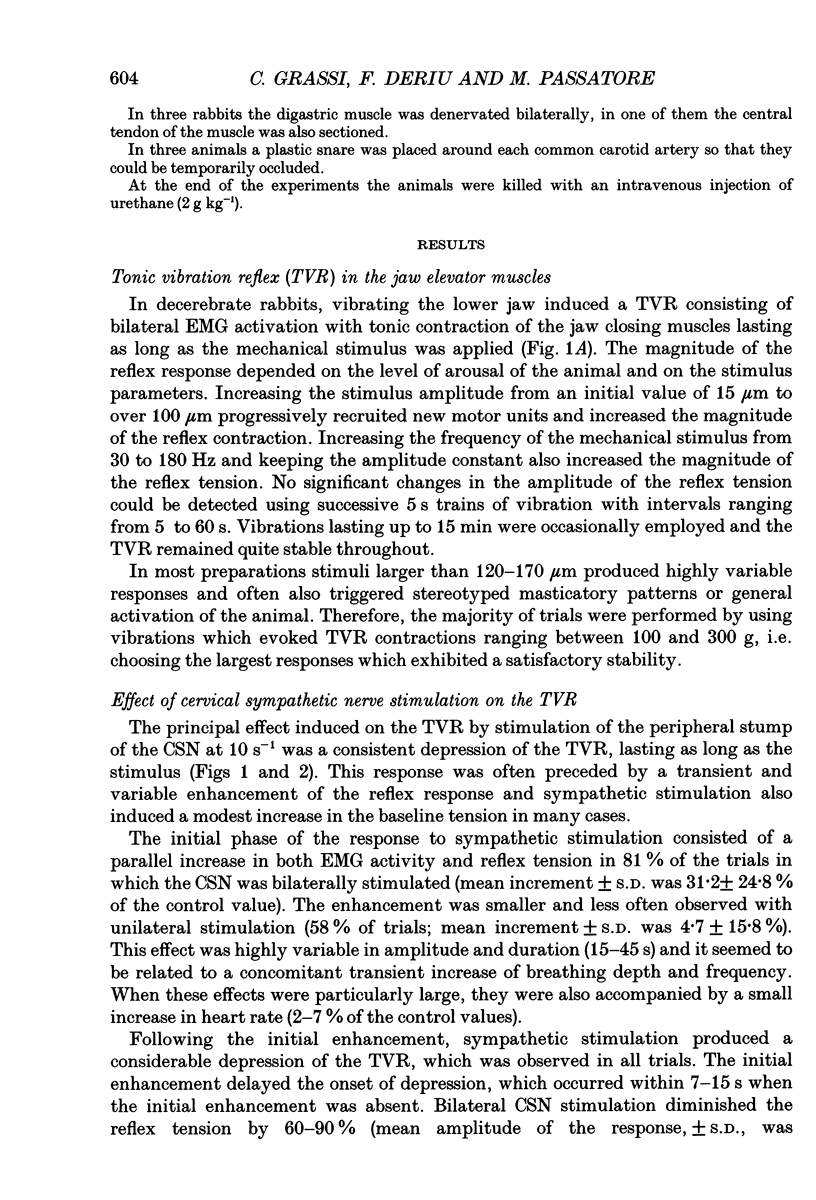
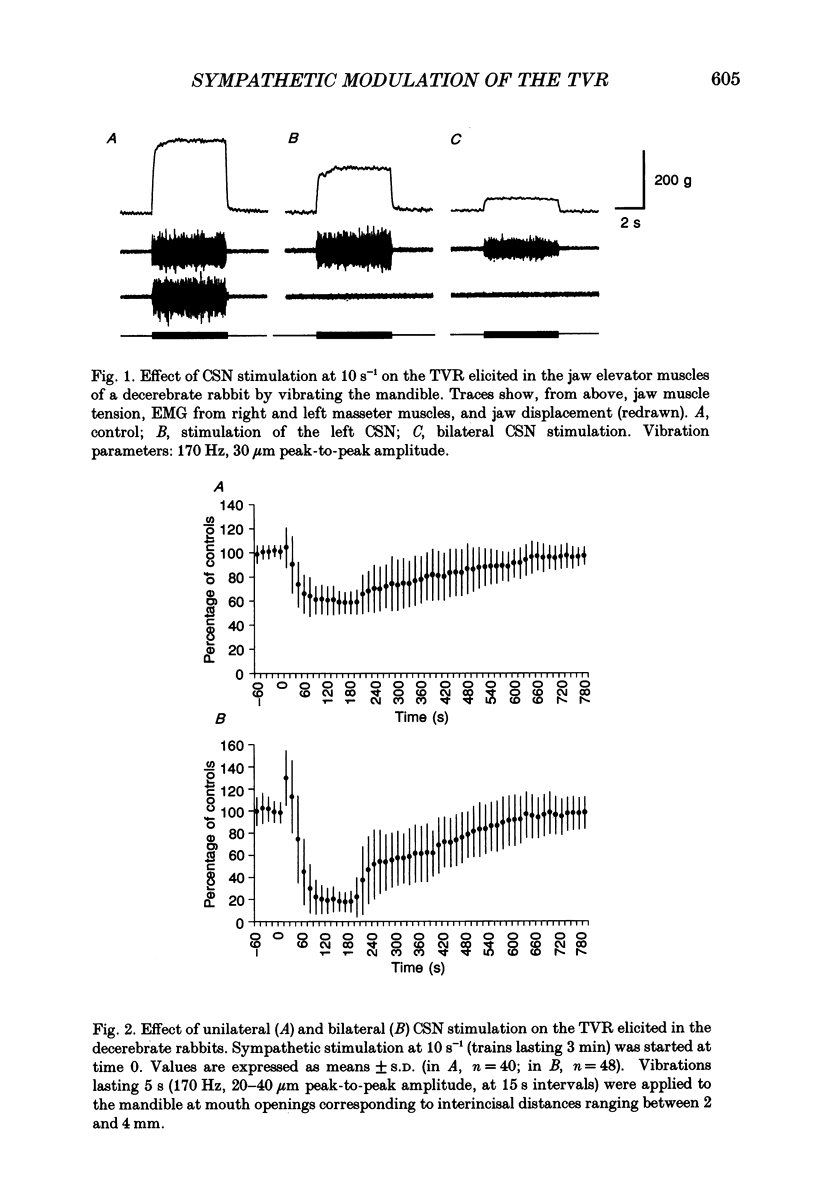
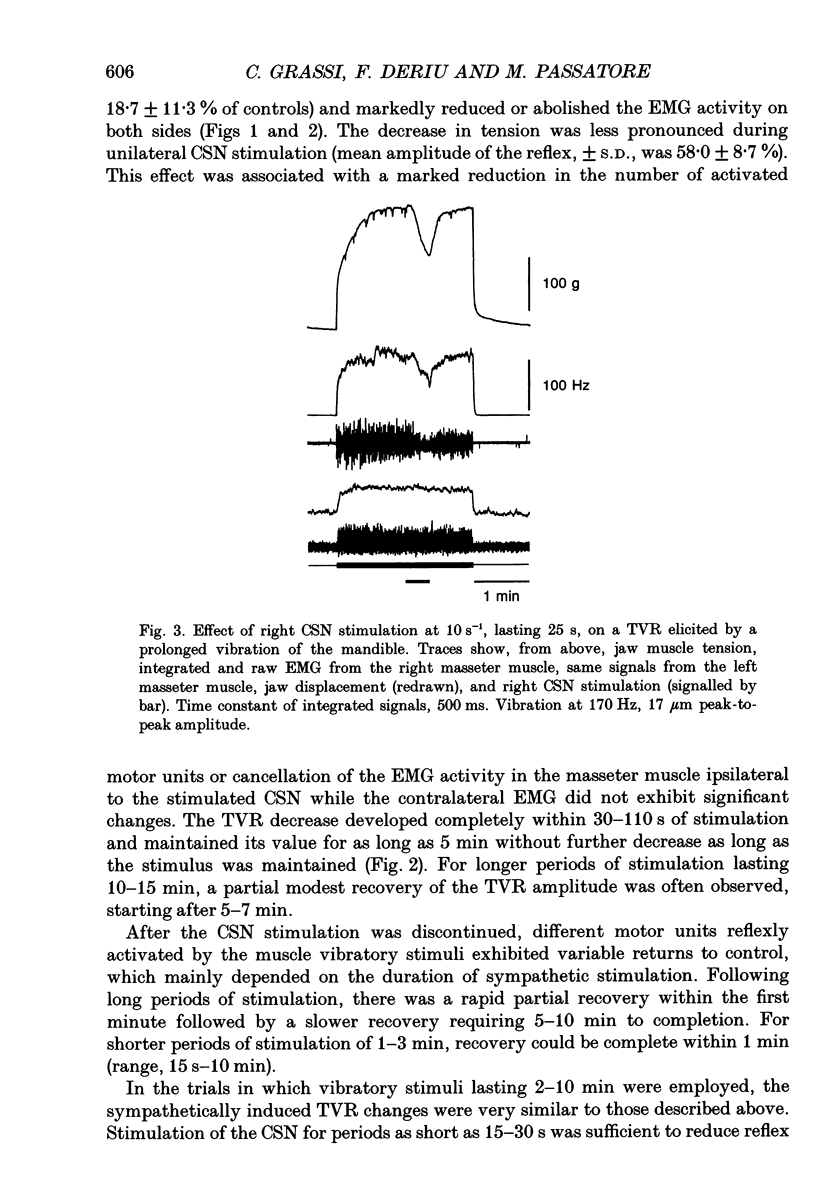
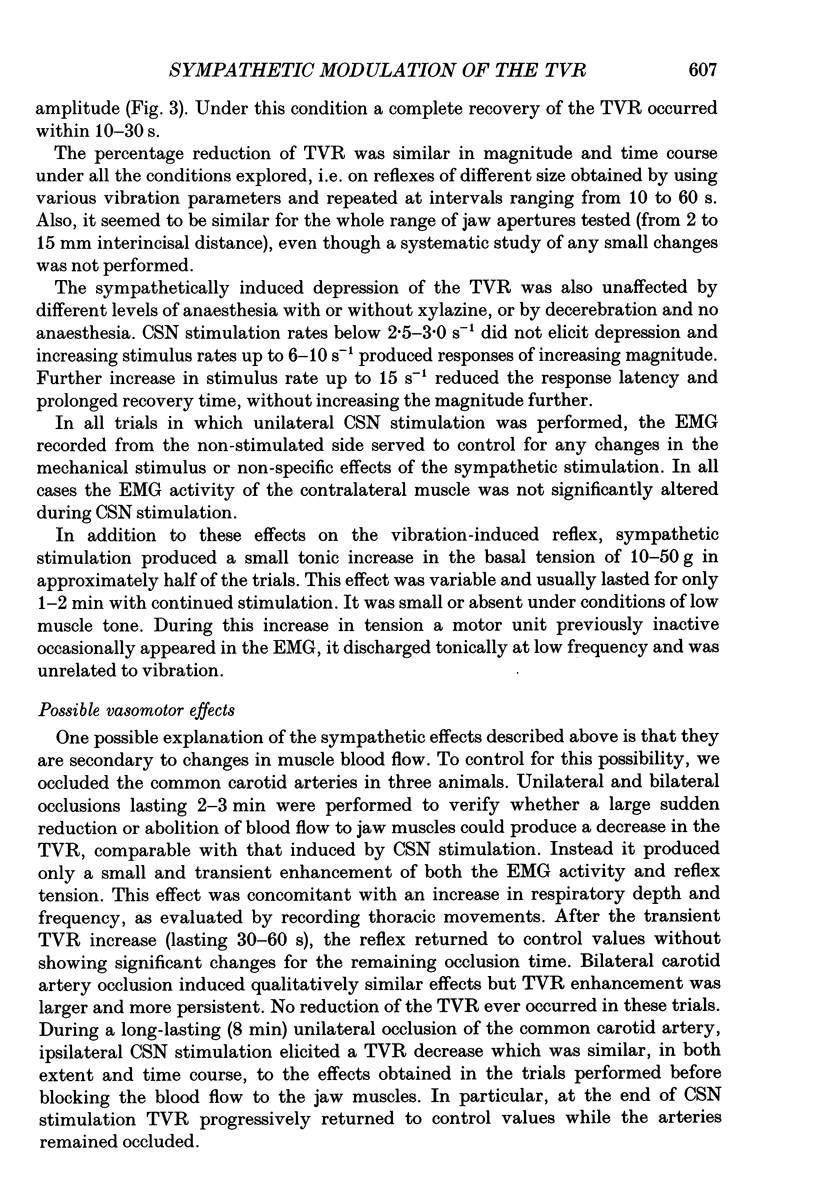
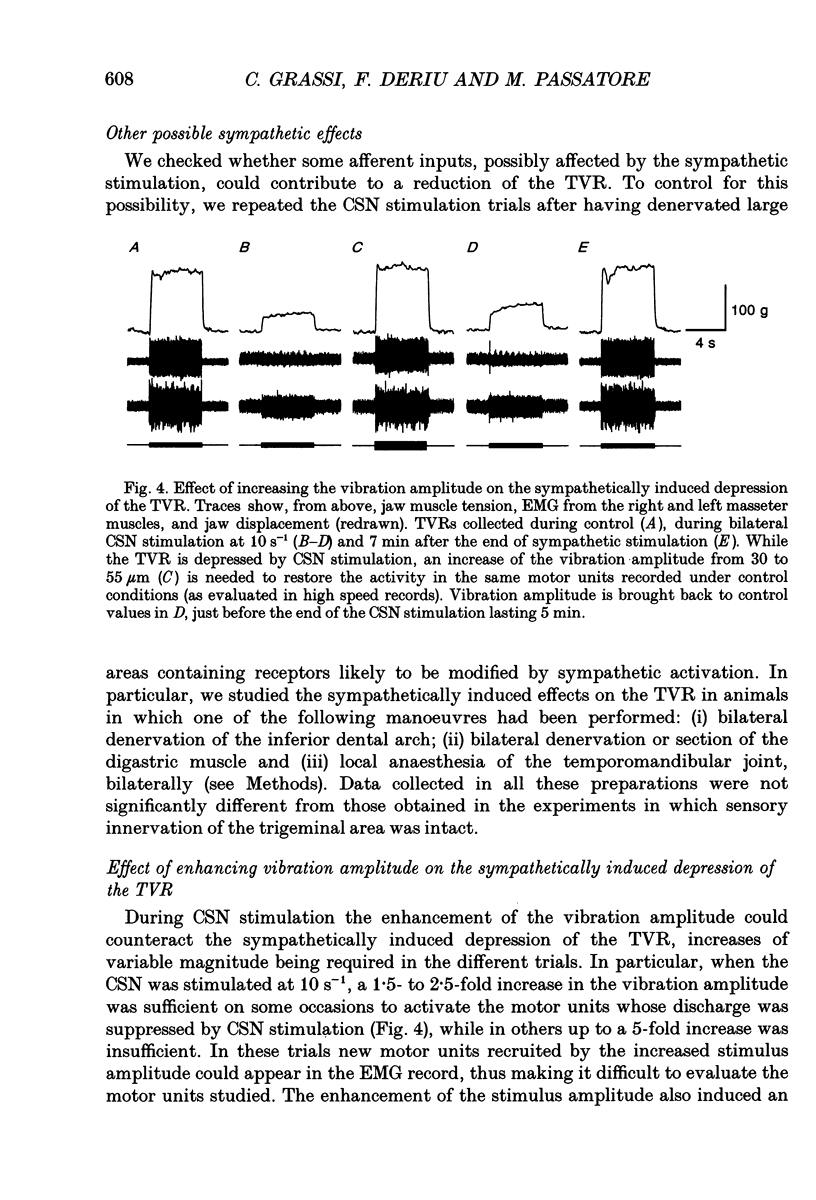
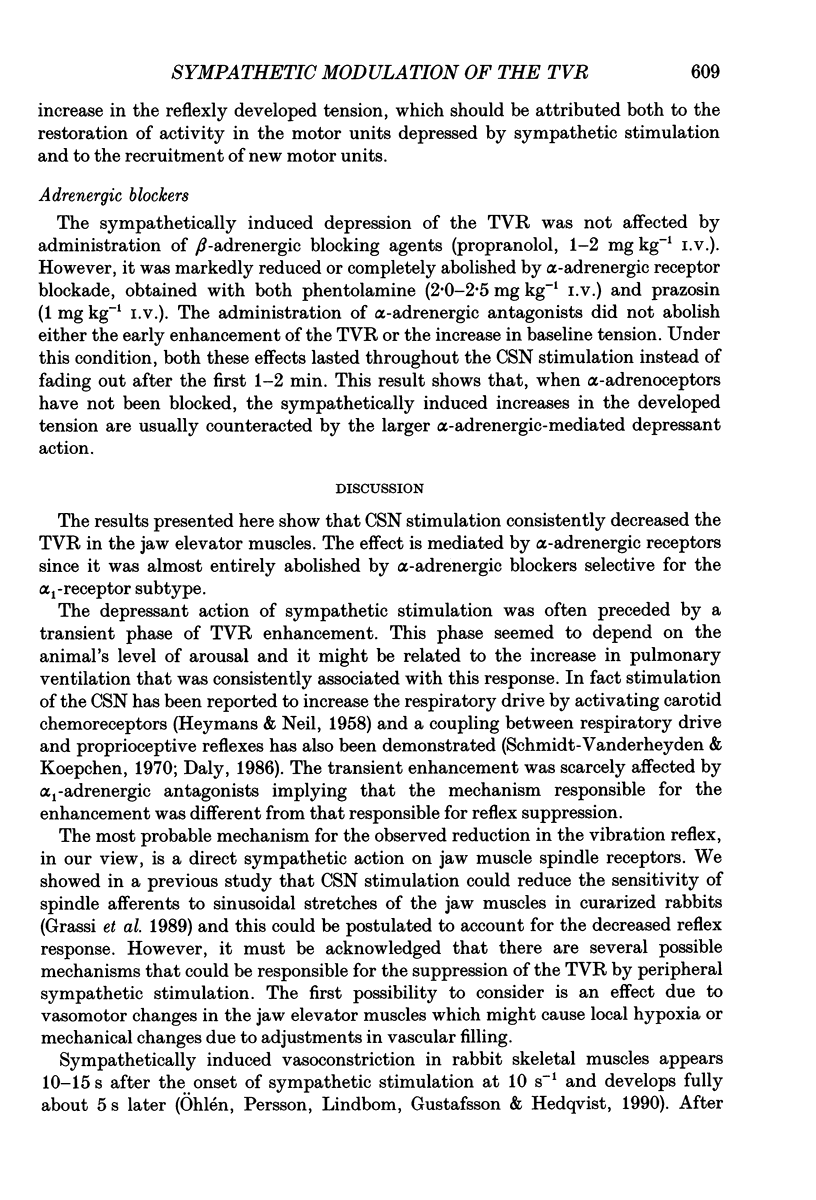
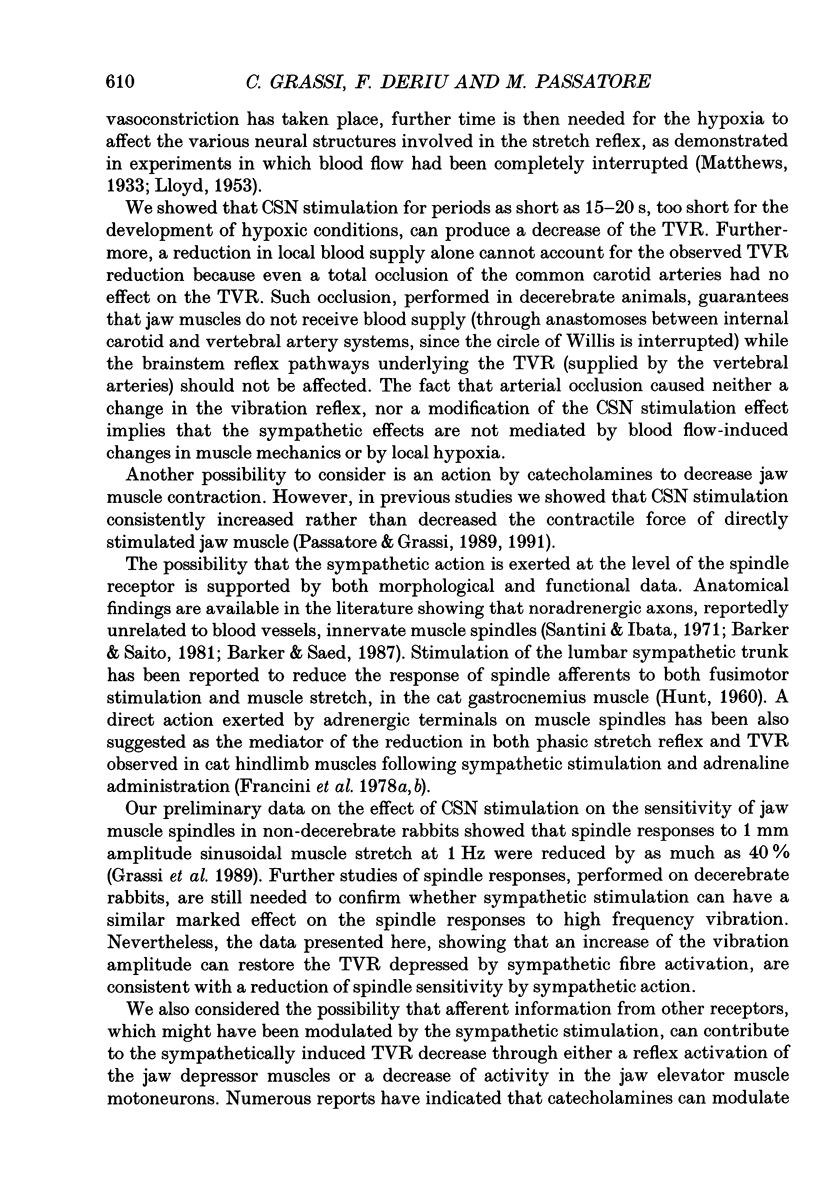
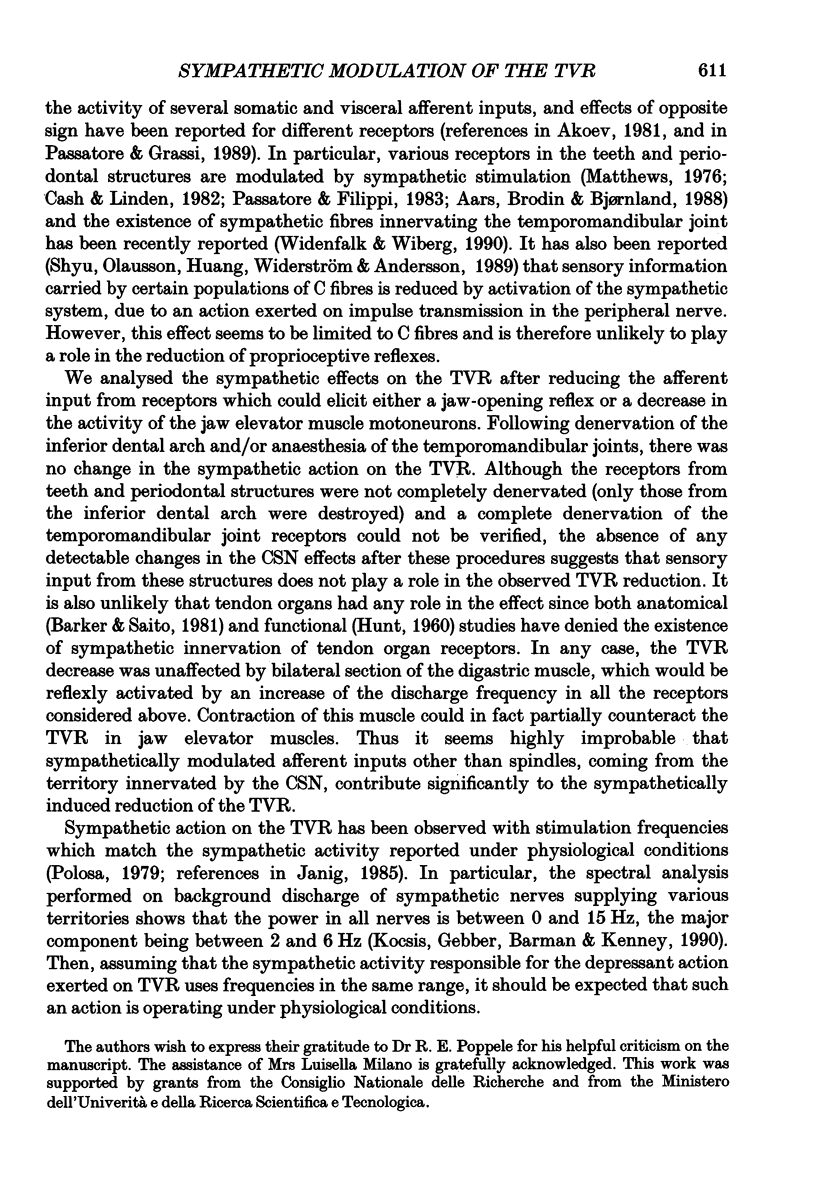
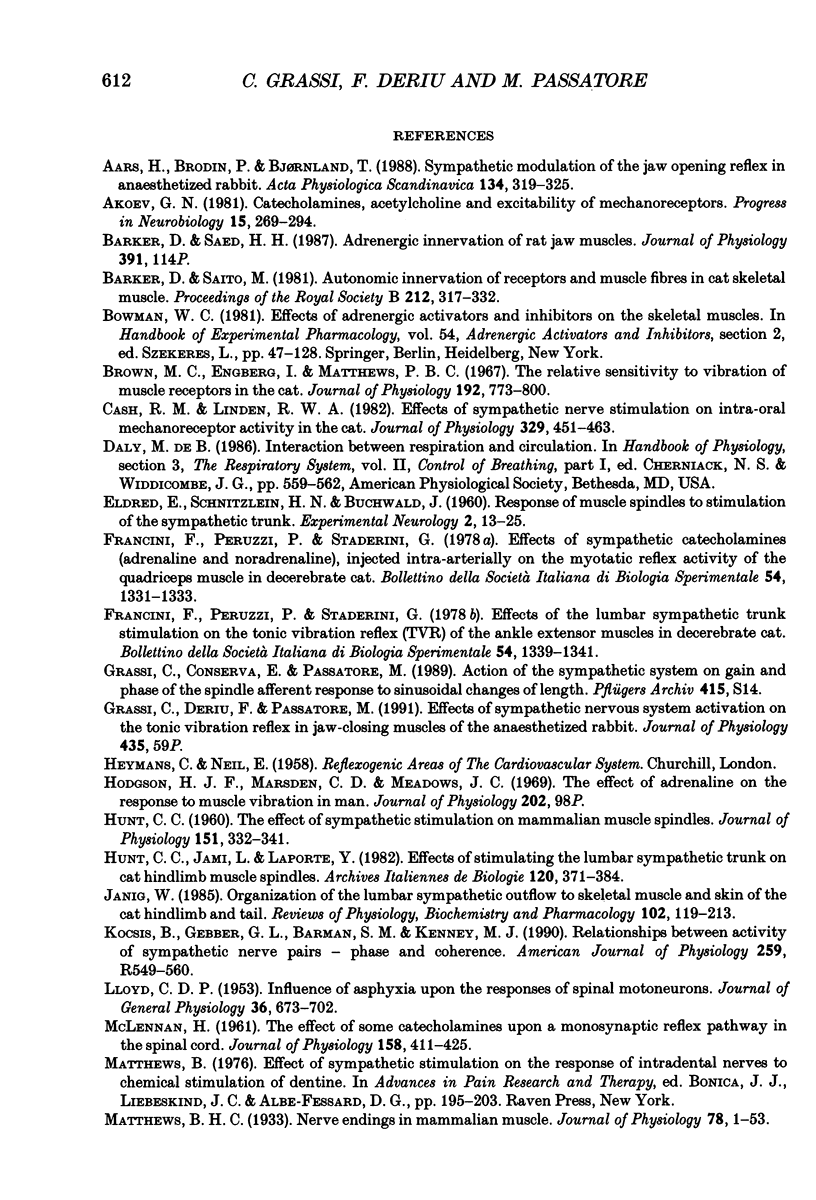

Selected References
These references are in PubMed. This may not be the complete list of references from this article.
- Aars H., Brodin P., Bjørnland T. Sympathetic modulation of the jaw-opening reflex in anaesthetized rabbits. Acta Physiol Scand. 1988 Nov;134(3):319–325. doi: 10.1111/j.1748-1716.1988.tb08498.x. [DOI] [PubMed] [Google Scholar]
- Akoev G. N. Catecholamines, acetylcholine and excitability of mechanoreceptors. Prog Neurobiol. 1980;15(4):269–294. doi: 10.1016/0301-0082(80)90007-6. [DOI] [PubMed] [Google Scholar]
- Barker D., Saito M. Autonomic innervation of receptors and muscle fibres in cat skeletal muscle. Proc R Soc Lond B Biol Sci. 1981 Jul 14;212(1188):317–332. doi: 10.1098/rspb.1981.0042. [DOI] [PubMed] [Google Scholar]
- Brown M. C., Engberg I., Matthews P. B. The relative sensitivity to vibration of muscle receptors of the cat. J Physiol. 1967 Oct;192(3):773–800. doi: 10.1113/jphysiol.1967.sp008330. [DOI] [PMC free article] [PubMed] [Google Scholar]
- Cash R. M., Linden R. W. Effects of sympathetic nerve stimulation on intra-oral mechanoreceptor activity in the cat. J Physiol. 1982 Aug;329:451–463. doi: 10.1113/jphysiol.1982.sp014313. [DOI] [PMC free article] [PubMed] [Google Scholar]
- ELDRED E., SCHNITZLEIN H., BUCHWALD J. Response of muscle spindles to stimulation of the sympathetic trunk. Exp Neurol. 1960 Feb;2:13–25. doi: 10.1016/0014-4886(60)90044-3. [DOI] [PubMed] [Google Scholar]
- Francini F., Peruzzi P., Staderini G. Effects of sympathetic catecholamines (adrenaline and noradrenaline), injected intra-arterially, on the myotatic reflex activity of the quadriceps muscle in decerebrate cat. Boll Soc Ital Biol Sper. 1978 Jul 30;54(14):1331–1334. [PubMed] [Google Scholar]
- Francini F., Peruzzi P., Staderini G. Effects of the lumbar sympathetic trunk stimulation on the tonic vibration reflex (TVR) of the ankle extensor muslces in decerebrate cat. Boll Soc Ital Biol Sper. 1978 Jul 30;54(14):1339–1341. [PubMed] [Google Scholar]
- HUNT C. C. The effect of sympathetic stimulation on mammalian muscle spindles. J Physiol. 1960 May;151:332–341. doi: 10.1113/jphysiol.1960.sp006441. [DOI] [PMC free article] [PubMed] [Google Scholar]
- Hodgson H. J., Marsden C. D., Meadows J. C. The effect of adrenaline on the response to muscle vibration in man. J Physiol. 1969 Jun;202(2):98P–99P. [PubMed] [Google Scholar]
- Hunt C. C., Jami L., Laporte Y. Effects of stimulating the lumbar sympathetic trunk on cat hindlimb muscle spindles. Arch Ital Biol. 1982 Sep;120(4):371–384. [PubMed] [Google Scholar]
- Jänig W. Organization of the lumbar sympathetic outflow to skeletal muscle and skin of the cat hindlimb and tail. Rev Physiol Biochem Pharmacol. 1985;102:119–213. doi: 10.1007/BFb0034086. [DOI] [PubMed] [Google Scholar]
- Kocsis B., Gebber G. L., Barman S. M., Kenney M. J. Relationships between activity of sympathetic nerve pairs: phase and coherence. Am J Physiol. 1990 Sep;259(3 Pt 2):R549–R560. doi: 10.1152/ajpregu.1990.259.3.R549. [DOI] [PubMed] [Google Scholar]
- LLOYD D. P. C. Influence of asphyxia upon the responses of spinal motoneurons. J Gen Physiol. 1953 May;36(5):673–702. doi: 10.1085/jgp.36.5.673. [DOI] [PMC free article] [PubMed] [Google Scholar]
- Matthews B. H. Nerve endings in mammalian muscle. J Physiol. 1933 Apr 13;78(1):1–53. doi: 10.1113/jphysiol.1933.sp002984. [DOI] [PMC free article] [PubMed] [Google Scholar]
- Matthews P. B. The reflex excitation of the soleus muscle of the decerebrate cat caused by vibbration applied to its tendon. J Physiol. 1966 May;184(2):450–472. doi: 10.1113/jphysiol.1966.sp007926. [DOI] [PMC free article] [PubMed] [Google Scholar]
- McLennan H. The effect of some catecholamines upon a monosynaptic reflex pathway in the spinal cord. J Physiol. 1961 Oct;158(3):411–425. doi: 10.1113/jphysiol.1961.sp006777. [DOI] [PMC free article] [PubMed] [Google Scholar]
- Ohlén A., Persson M. G., Lindbom L., Gustafsson L. E., Hedqvist P. Nerve-induced nonadrenergic vasoconstriction and vasodilatation in skeletal muscle. Am J Physiol. 1990 May;258(5 Pt 2):H1334–H1338. doi: 10.1152/ajpheart.1990.258.5.H1334. [DOI] [PubMed] [Google Scholar]
- Passatore M., Filippi G. M. Sympathetic modulation of periodontal mechanoreceptors. Arch Ital Biol. 1983 Jan;121(1):55–65. [PubMed] [Google Scholar]
- Passatore M., Grassi C., Filippi G. M. Sympathetically-induced development of tension in jaw muscles: the possible contraction of intrafusal muscle fibres. Pflugers Arch. 1985 Dec;405(4):297–304. doi: 10.1007/BF00595681. [DOI] [PubMed] [Google Scholar]
- Santini M., Ibata Y. The fine structure of thin unmyelinated axons within muscle spindles. Brain Res. 1971 Oct 29;33(2):289–302. doi: 10.1016/0006-8993(71)90104-1. [DOI] [PubMed] [Google Scholar]
- Schmidt-Vanderheyden W., Koepchen H. P. Investigations into the fluctuations of proprioceptive reflexes in man. II. Fluctuations of the patellar tendon reflex and their relation to vegetative rhythms during controlled respiration. Pflugers Arch. 1970;317(1):72–83. doi: 10.1007/BF00586700. [DOI] [PubMed] [Google Scholar]
- Shyu B. C., Olausson B., Huang K. H., Widerström E., Andersson S. A. Effects of sympathetic stimulation on C-fibre responses in rabbit. Acta Physiol Scand. 1989 Sep;137(1):73–84. doi: 10.1111/j.1748-1716.1989.tb08722.x. [DOI] [PubMed] [Google Scholar]
- Widenfalk B., Wiberg M. Origin of sympathetic and sensory innervation of the temporo-mandibular joint. A retrograde axonal tracing study in the rat. Neurosci Lett. 1990 Feb 5;109(1-2):30–35. doi: 10.1016/0304-3940(90)90533-f. [DOI] [PubMed] [Google Scholar]


